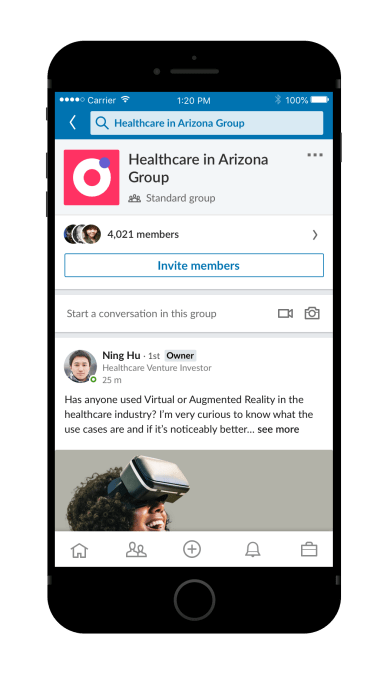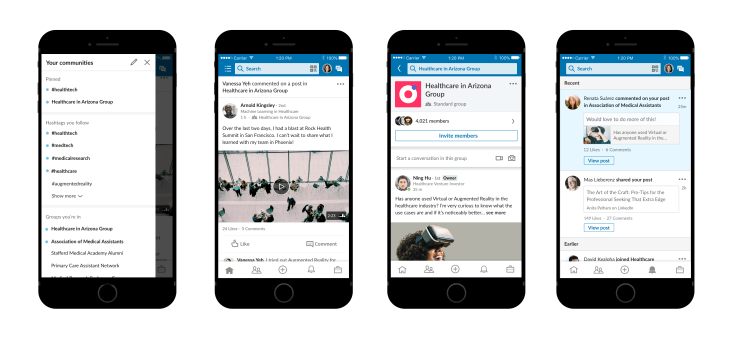LinkedIn, the Microsoft-owned social networking platform for the working world with over 500 million users, is making a significant change as it continues to look for ways to make its platform more useful (and used).
The company is relaunching Groups by rolling it into its main app by the end of the month after quietly pulling the standalone app earlier this year, and it will be streamlining the service by cutting out several features, including an ability for Group administrators to pre-moderate comments; and a way to email send Group posts as emails to the whole group, while also adding in new features like threaded replies and the ability to post video and other media.
 An announcement detailing the changes was sent out to a select Groups power users earlier today, and we have confirmed the details with LinkedIn directly. Mitali Pattnaik, the product manager for Groups, said that some of the discontinuations — such as the ability to approve posts before they are live — are temporary and will make their way back to the app in some form over time.
An announcement detailing the changes was sent out to a select Groups power users earlier today, and we have confirmed the details with LinkedIn directly. Mitali Pattnaik, the product manager for Groups, said that some of the discontinuations — such as the ability to approve posts before they are live — are temporary and will make their way back to the app in some form over time.
The moves come nearly three years after LinkedIn tried another approach to put some more wind into Groups’ sails. In 2015, the company hived off an updated version of Groups into its own standalone app.
Included in the changes, Groups were made private with the aim of reducing some of the spam that people were posting. The bigger idea was that, with some 2 million Groups already on LinkedIn, users would be able to dedicate more time to posting, reading and managing (if they were admins) those groups, and creating new groups, once they were in their own app. And on the part of LinkedIn, it would help the company focus on developing features specifically tailored to the Groups experience.
But the move did not go down well. In the wake of the changes, reports started to surface about how the moves stifled usage of groups, turning the platform into what some were calling a ghost town. And LinkedIn itself, it seems, was finding it a challenge to continue updating the app, even as LinkedIn itself was getting enhanced with new features.
“Being a standalone app, Groups was not able to take advantage of the overall LinkedIn ecosystem,” Pattnaik said. “Everything from the news feed to notifications to search, these things move at a fast pace, and the minute the apps got separated the main app innovated at a much faster pace and became more advanced than the standalone Groups app.”
LinkedIn then quietly pulled the Groups app in February this year, as it announced plans to integrate the feature.
It’s not clear what kind of impact the last three years have had on the product. These days company does not comment on how many groups there are, nor how much they are used, except to say that there are “over 2 million” and that more than half of all LinkedIn members are at least in one group. (The person who oversaw Groups’ move to becoming a standalone app is also no longer at the company.) LinkedIn’s main app, on the other hand, has seen session time rise by 41 percent year-on-year, “growing consecutively for several quarters.”
The removal of the standalone app is in line with how another social network has evolved its own Group effort. Almost exactly a year ago, Facebook announced that it too was killing off its Groups app so that it could integrate the feature closer with the core app experience. In both the case of LinkedIn and Facebook, the idea is somewhat the same: while we have our wider networks of friends and Pages that we follow on both platforms, sometimes there is value in communities that are focused around more specific interests, and ultimately, that might turn out to be the lever that brings more people in and out of using the main service.
On a product iteration level, it seems that LinkedIn is not the only one that found it hard to keep up with changes across two platforms that essentially rested of many of the same mechanics.
As part of being rebuilt on LinkedIn’s platform, Groups will be getting a number of new features — essentially tapping into new features that LinkedIn has rolled out over the last several quarters on its own app but hadn’t built for the (previously standalone) Groups platform.
For starters, conversations taking place in Groups will now appear in-stream on the LinkedIn feed, rather than in a separate tab. When group members are replying to posts, there will now be threaded replies, which will let people respond directly to comments within the thread.
Groups are also going to have a rich media infusion: users will be able to edit posts and share videos and other non-text formats. This is a very long overdue feature, considering how central video and rich media like GIFs have been on other platforms in getting people engaged in a service, and also considering that LinkedIn’s been showing video in its feed for a while now. “Since video launched on LinkedIn, Groups have been asking for this,” she said.
It also looks like LinkedIn will also be pushing a lot more Group activity into your notifications tab, while alongside this, it’s sunsetting the e-mail blast. That might not be such a bad thing: while it did help admins get information out (especially when Groups updates were essentially hidden from the average LinkedIn user), Pattnaik admitted that the email feature “can be abused” by those simply looking to promote themselves.
Admins are also getting a few new controls. They will be able to pin important items to the top of a Groups’ individual feed, and Pattnaik said that LinkedIn is working on a way to collapse those pinned notifications after they’ve been viewed by the member so that they don’t continue to take up space. They will also be able to approve and remove members by way of the app, as well as send out messages when necessary.
[gallery ids="1691948,1691949,1691950"]
LinkedIn, it seems, hopes that people will be able to use the LinkedIn app to discover more Groups that they can join — when Groups choose to have themselves “listed” and discoverable — but one thing that won’t be changing with the new version is that those users will still have to get permission from admins before they can join.
While Groups have a lot in common with how groups of employees might communicate using a messaging app like Slack (or stablemate Yammer, or Facebook’s Workplace) LinkedIn says that it has no plans at the moment to develop Groups into something that could be used in this way.
The reason for this, Pattnaik says, is that for the moment LinkedIn isn’t focused on developing a way to verify whether a person is actually an employee at a particular company. “We are always evaluating ways to verify identity across the site, such as verification processes to help detect fake profiles,” a spokesperson said. It has made some small steps in building products for company-only teams, however, for example Elevate to share content among coworkers.
In the meantime, the company is also continuing to develop other products beyond the main app. Just today, Sales Navigator got a quarterly refresh with more tools to update on deals, stronger integration with CRM apps and more.
